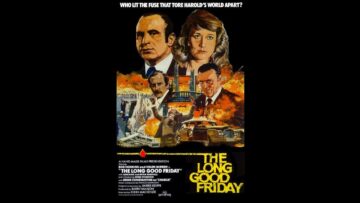Ryan Gilbey at The Current:
 The Long Good Friday whisks audiences across late-1970s London, taking in everything from the Concorde landing at Heathrow Airport to the desolate undeveloped Docklands, from the chauffeur-driven cars at the Savoy Hotel to the beat-up jalopies south of the Thames. The film’s heart, though, is in the East End, and so are its roots. By 1964, when Barrie Keeffe joined the Stratford Express as a cub reporter, the area was a hotbed of organized crime. Its figureheads were the twins Ronnie and Reggie Kray, notorious gangsters who insinuated themselves into the celebrity set. Keeffe had witnessed too much of their carnage to be dazzled. At eighteen, he interviewed a man who had been nailed to a warehouse floor by the brothers over a territorial dispute: “Put it down as a do-it-yourself accident,” the man said, refusing to snitch even as he nursed his stigmata. When Keeffe came to write his first film, he put in a crucifixion scene, fittingly for a story set over Easter.
The Long Good Friday whisks audiences across late-1970s London, taking in everything from the Concorde landing at Heathrow Airport to the desolate undeveloped Docklands, from the chauffeur-driven cars at the Savoy Hotel to the beat-up jalopies south of the Thames. The film’s heart, though, is in the East End, and so are its roots. By 1964, when Barrie Keeffe joined the Stratford Express as a cub reporter, the area was a hotbed of organized crime. Its figureheads were the twins Ronnie and Reggie Kray, notorious gangsters who insinuated themselves into the celebrity set. Keeffe had witnessed too much of their carnage to be dazzled. At eighteen, he interviewed a man who had been nailed to a warehouse floor by the brothers over a territorial dispute: “Put it down as a do-it-yourself accident,” the man said, refusing to snitch even as he nursed his stigmata. When Keeffe came to write his first film, he put in a crucifixion scene, fittingly for a story set over Easter.
That script, which Keeffe pitched as “terrorism meets gangsterism,” pitted Harold Shand, a Krays-style East End gang lord, against the IRA.
more here.
Enjoying the content on 3QD? Help keep us going by donating now.
